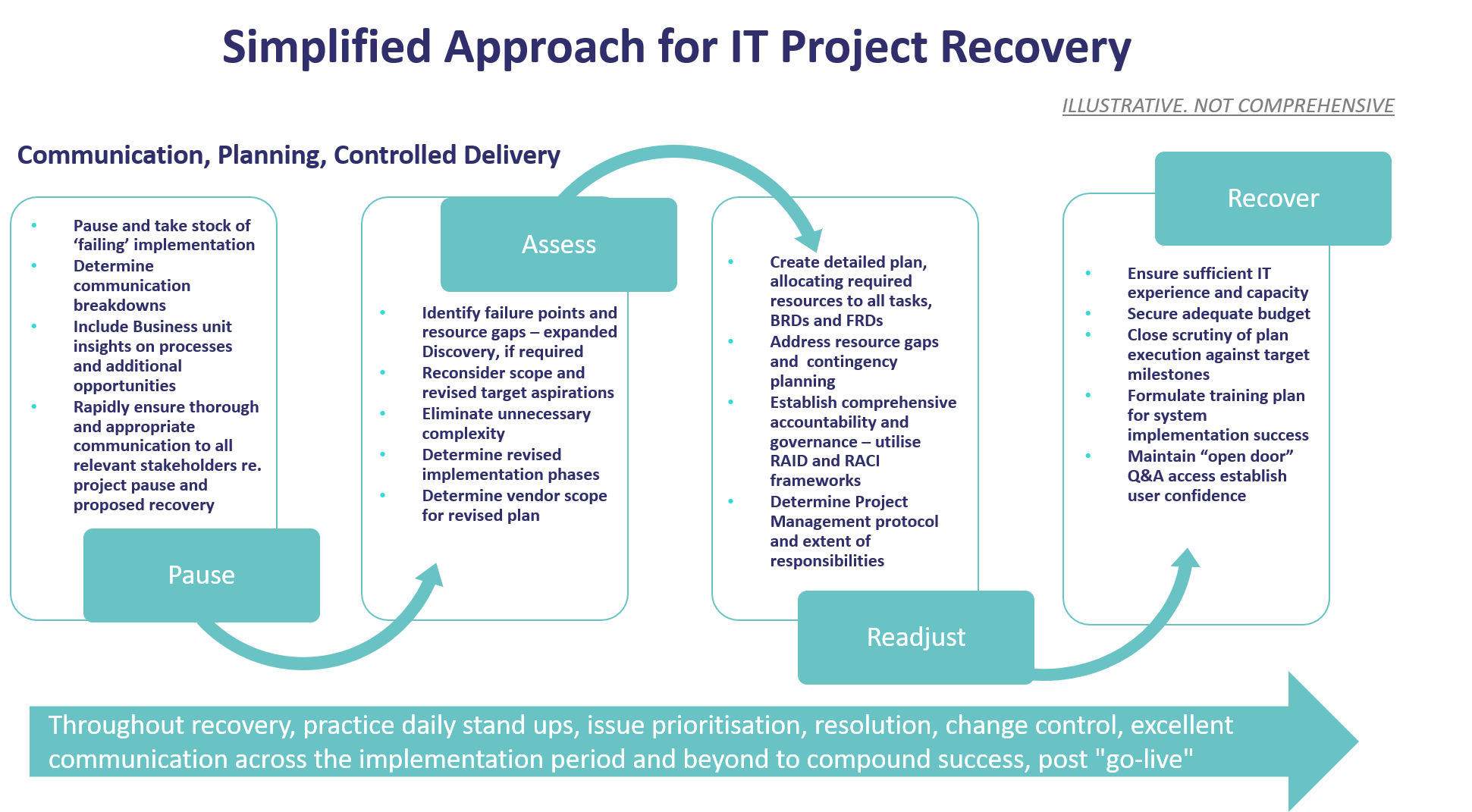How to Correct a Failing Project
Here is what we do to help new clients that come to us with just such a problem. To start with, you can read another of our client cases here, where we managed to get a failing ERP implementation back on rails and successfully implemented in just 8 weeks, Health Check Recovers Failing ERP Project | Panamoure Consulting, and demonstrates that ‘failing’ projects can be recovered.
Secondly, this schematic summarises the typical procedure we would employ to get most ‘failing’ projects back on course, assuming that abandonment is not the better course. It’s by no means comprehensive but will give you a flavour of what might be required to get you back on track.

Here are those 4 elements in a bit more detail.
- Pause – subject to critical business functions continuing and any critical failures rapidly addressed, the sensible course of first action is to pause. This permits the implementation team, project managers, business unit managers, end users and other stakeholders to take stock and reflect on why things have gone awry. Some may feel they do not need that pause, but almost certainly some of your IT professionals, or other stakeholders, will be suffering from some level of anxiety or frustration with how the project is failing to progress. Depending on the stage of the project along its roadmap and the extent of team involvement, a pause is frequently the most sensible first ‘action’. Start talking!
- Assess – This is the opportune period to revisit the original scope and targeted result; to check priorities and determine where the plan and its roadmap is failing. What else should have been in place to ensure successful delivery and to meet the original goals? Should you have included more input from both the IT and Business components of the company? It is also the time to address the original system decision and rationale. Reassess the adequacy of any vendors, and their motives. As we’ve already pointed out, there are many examples out there of where inappropriate vendors and platforms were selected for the target solution. As one of our team members nicely put it “If you’re driving a Fiat, you don’t need a Ferrari engine”. Are the original choices still fit for project delivery? Or would it be better, more cost effective to abandon or substantially revise?
- Readjust – properly plan for correction. Fully consider the most efficient and cost-effective way to get back to the original project scope. But also recognise that whatever has slowed, or derailed project delivery may not be an isolated factor. There may well be other issues within a flawed roadmap and delivery plan that may yet encourage failure further along.
This time, be more thorough. Reconsider obtaining greater insight from your Business operations to revise delivery targets, requirements and budget to fit with a detailed re-timetabling. Establish a proper phased approach and this time, don’t skimp. Your project ‘failure’ may be a budget overrun but a proper investment into this new, but possibly truncated Discovery phase, will ultimately help deliver a better ROI.
If you neglected your stakeholder communication pre-’failure’, don’t make the same mistake post-‘failure’. Get the communication right. For a recovery, the last thing you need is employee resistance, and this is more likely post-‘failure’. So, make your communication a priority as you Readjust and Recover.
- Recover – having established revised requirements and better communication, also ensure proper governance and clear accountability to include a competent and enabled Project Manager. Ensure implementation team competency and capacity and that all fits together to work through your revised delivery plan and to mark milestone targets against an achievable and clearly communicated timetable.
If, this time, your revised implementation plan incorporates all the carefully considered factors we itemised, then your improvement stands a much better chance of successful delivery second time around and you can start to limit costs associated with a failing IT project.
Of course, rather than charging ahead with an ill-structured and ill-timed plan, better to “get it right first time”.







